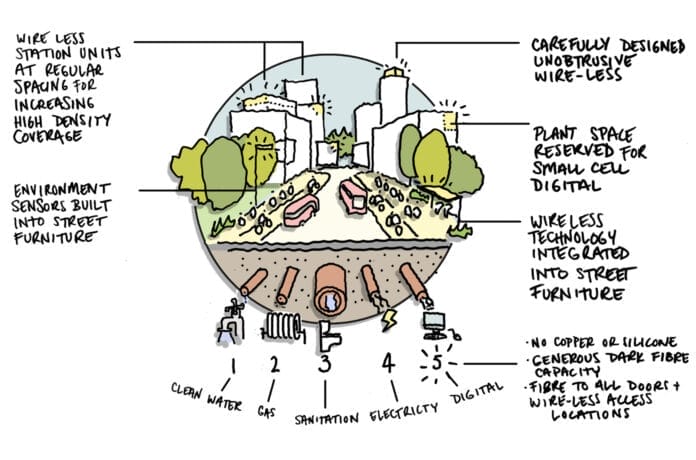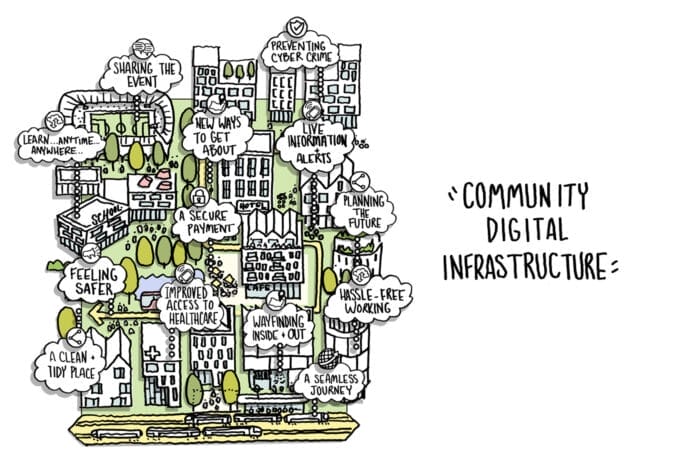
As smart buildings become commonplace, what are the possibilities of applying this technology in the future?
HLM Architects’ Duncan Thomas, Masterplanner and Architect, and Ceri Williams, Enterprise Architect from DesignITin, discuss the latest developments in technology and their impact on cities of tomorrow.

Smart buildings are no longer a new concept; their guiding principles are becoming increasingly established as they mature. Buildings can now produce performance metrics in real-time, based on user behaviour and patterns, enabling greater efficiency and improved user experience. The latest developments in digital technology present the opportunity to extend this approach to the design of neighbourhoods and cities – Introducing ‘Smart Places’.
“A comprehensive, high speed, high-capacity digital infrastructure offers huge opportunity to our public services and environment. Enabling better informed, more responsive decision-making will shape the future of our cities and ultimately help to make a more accessible, equitable and healthier place.”
By incorporating digital infrastructure from the outset, the benefits to the community will spin out in ever-growing depth. An integrated, comprehensive, community-wide digital infrastructure offers improved access to transport, education and healthcare, alongside broader-reaching environmental benefits including improved air quality and reduced carbon emissions.

Digital: The 5th Utility
The first step identified by Duncan and Ceri is the need to consider digital as the ‘5th Utility’. Digital technology must be incorporated into the design and construction of streets, spaces and buildings at the same time as the other essential utilities of everyday life – water, gas, sanitation and electricity. No copper or silicon cabling is permitted – strictly fibre to all locations. The capacity of the network is future-proofed through the generous inclusion of additional ‘dark fibre’ (unconnected spare fibre cabling).
Above ground, the digital infrastructure must also be conceived from the outset. Wire-less technology, such as WiFi and 5G, is carefully designed into new buildings and public realm. High-density, high-speed internet coverage is achieved within the neighbourhood through the regular spacing of wireless stations. Unsightly towers and microwave dishes are out – instead, the new kit is incorporated within the plant spaces of buildings – currently designed to handle the other four utilities. Environment sensors, such as air quality monitors and traffic measurement, can be integrated into street furniture.

By designing-in digital infrastructure below ground from the outset, the disruption, expense, unsightliness and waste of resources of retrofitting new technology is avoided. This integrated, and comprehensive network offers dependable, high-speed digital connections with capacity for growth.

Once this digital infrastructure has been established, the benefits of Smart Placemaking are ready to be realised…
Healthcare
- Digital ‘front door’ access to in-person and telehealth services, with continuity on and offsite. Enabling a streamlined user experience, with integrated virtual and in-person appointments, enabling patients to experience the same quality of care whether in person or online.
- Wire-less connection of wearable ‘Med-tech’ monitoring devices indoors or outdoors providing clinicians and population health professionals with a ‘rich picture’ to tune health care.
- Reliable connectivity enabling high quality care in the community and rapid, seamless transfers of care between the NHS and Social Care providers.
- Wayfinding – Integrated wayfinding across district hospitals, clinical departments and other services
Education
- Learning – frictionless student access to learning and social resources anywhere, anytime, using any device.
- Ubiquitous, high availability & high-capacity connectivity enabling consistent and coherent experience across both centralised and highly dispersed campuses.
- Reliable, low-latency connections provide more possibilities for learning designers to integrate real-time, interactive learning into the curriculum.
Work
- Hassle-free working – seamless, hassle-free roaming between work and leisure locations, without interruption or signing in needed. The added security and reliability built into the network removes the need for additional VPN connections, portals and verifications associated with remote working. Instead, users enjoy the same experience whether in the office, at home, café or park.
Leisure
- Sharing the Event – short burst increased network capacity to allow continuous access at large events, including personal video and social media sharing.
- Live info and alerts – Real-time, location-based alerts and offers from hospitality and retail outlets.
- Secure Payment – Reliable, secure, wireless open-air access to street vendors and pop-ups for payments.
Getting About
- A seamless Journey – integrated journey planning across different transport modes. Real-time re-planning of journeys that adapt to traffic conditions or delays Journeys are connected whether they are via train, tram, bus, or a new, demand-responsive service.
- New ways to get about – the neighbourhood has the capacity to adapt quickly to the implementation of new modes of transport such as e-bike hire, car sharing, autonomous vehicles and EV charging.
Some of the deeper benefits of the community digital infrastructure is to be found in the opportunity the network provides in supporting city governance.
Supporting governance and leadership: Smart management and placekeeping
The infrastructure not only enables communication but improved analysis and monitoring of the place. This infrastructure provides metrics for Local Authorities to use for positive district development which is representative of their users.
- Feeling Safer – Citizen trust in physical safety and security measures – the correct level and location of surveillance, lighting control, and incident detection
- A clean and tidy place – Well-maintained civic spaces at lowest cost through asset management, condition-based maintenance and services including waste collection and street cleaning
- Preventing cyber crime – Trusted, secure connection and access without the fear of cyber crime
- Smart traffic management – the sensors and monitoring incorporated into the neighbourhood infrastructure is used to manage traffic flow and reduce congestion. Rapid collection of data is also used to guide future design of roads, streets and spaces. This does not replace the way transport infrastructure data is collected and analysed, but a new, efficient methodology for doing so. A much more adjustable, responsive and speedy collection of data replaces the existing expensive, labour intensive and protracted process.
- Precise environmental monitoring to inform planning and real-time interventions.
Supporting governance and leadership: Smart planning the future
Some of the most profound benefits from the community digital infrastructure can be found in its ability to inform and support the decision making of governance and leadership. Long term development plans can be drawn up with a more up-to-date evidence base, without the need to commission point-in-time surveys. Data can be drawn upon to assess areas of the city that are functioning well and identify areas that are underperforming, allowing future plans to be better tailored to suit specific needs of areas.
Smart Places present many opportunities to create healthier neighbourhoods with improved access to healthcare, education and work, where sustainable transport options are the preferred choice.
They can also help us work towards a more inclusive and equitable society, better informed on how we expend resources when managing, growing and adapting our neighbourhoods.
To ensure that communities are fully connected and ready for the future, we must address the stage at which digital infrastructure is considered. The 5th Utility must become as integral to the design of new neighbourhoods as the engineering of water, power and sanitation. To be successful, blending digital into the design of new communities has to become a collective, open, inter-organisational effort. We hope this will enable local authorities and other commissioning organisations to become Informed Clients when conceiving, designing, procuring, delivering and operating Smart Places.
To continue the conversation, contact Duncan.thomas@hlmarchitects.com.
Related posts

Innovation Districts: What is the Role of HE Institutions in Maximizing Potential for Growth?
Read more ↓
